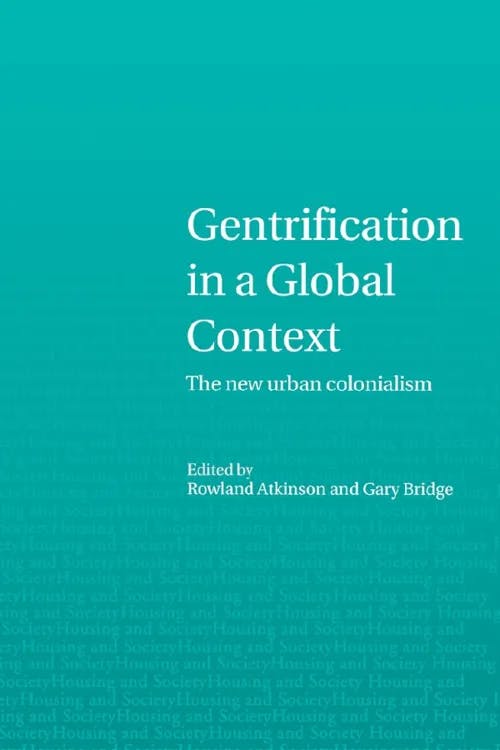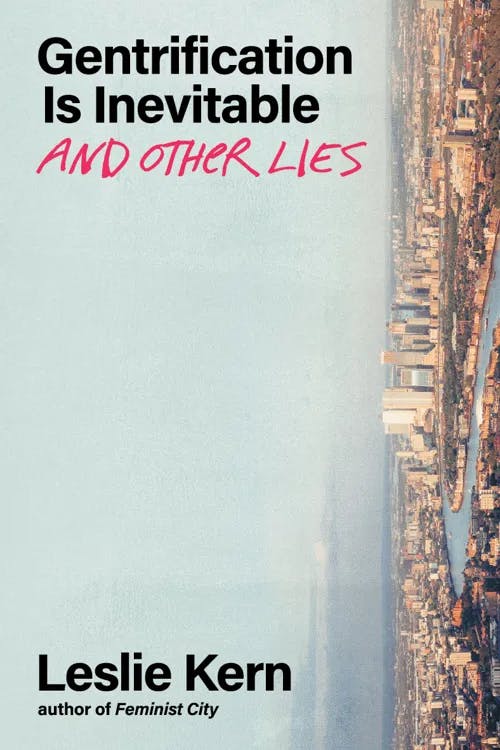What is Gentrification?
MA, Sociology (Freie Universität Berlin)
Date Published: 14.11.2023,
Last Updated: 14.11.2023
Share this article
Defining gentrification
Gentrification is the complex process by which urban areas trend towards higher property values, accompanied by an influx of wealthier residents and higher-end businesses. It is a phenomenon that became of particular interest to scholars in the 1970s, and it has remained a topic of focus across a number of disciplines including urban planning, sociology, and geography. Gentrification is a fairly slippery term because it encapsulates so many things — including genuine neighborhood revitalization efforts. But as Neil Smith and Peter Williams observe in Gentrification of the City (2013),
If we look back at the attempted definitions of gentrification, it should be clear that we are concerned with a process much broader than merely residential rehabilitation. Even into the late 1970s, this particular definition of gentrification vis-a-vis redevelopment may have made some sense. But as the process has continued, it has become increasingly apparent that residential rehabilitation is only one facet (if a highly publicized and highly visible one) of a more profound economic, social, and spatial restructuring.
Edited by Neil Smith and Peter Williams
If we look back at the attempted definitions of gentrification, it should be clear that we are concerned with a process much broader than merely residential rehabilitation. Even into the late 1970s, this particular definition of gentrification vis-a-vis redevelopment may have made some sense. But as the process has continued, it has become increasingly apparent that residential rehabilitation is only one facet (if a highly publicized and highly visible one) of a more profound economic, social, and spatial restructuring.
The discourse around gentrification is filled with controversy around the net benefits of this process of restructuring. Some argue that its effects are positive because they improve the overall economic outlook of an area. Others contend that gentrification only benefits a small, affluent group of people while further displacing and marginalizing low-income and minority groups. Initially, gentrification research focused on New York and London, but gentrification is now prevalent in major cities around the world.
Regardless of any given stance on the topic, it is important to understand gentrification as a multifaceted process. This study guide covers the major features that play into the phenomenon of gentrification — including the financialization of the housing market, public policy initiatives, and demographic changes. It also explores the complex impacts, which extend beyond urban spaces to influence how we think, what we desire, and who has agency to shape the urban environments in which we live. We’ll conclude by questioning whether gentrification is inevitable and what is being done to mitigate its more negative impacts.
Features of gentrification
Real estate speculation
The exact root cause of gentrification is controversial. Some scholars, such as urban geographer David Harvey, believe that the process starts long before there are visible symptoms such as changing demographics in a given neighborhood, more expensive shops, and so on. Rather, the process begins with something that is more abstract and less obviously visible: real estate speculation and the financialization of the housing market. Harvey argues that, particularly since the mid-1970s, real estate investment began to serve as a short-sighted way to remedy crises of capital overaccumulation.
Real estate has since become an increasingly popular — and profitable — vessel for investment that has seen sharply rising returns, and with it, rising rents and property prices for consumers. Harvey explains how the growing emphasis on property as an outlet for speculative investment means that,
The class interests involved on the production side are, however, also lopsided […]. Bankers, developers, and construction companies easily combine to forge a class alliance (one that often dominates what is called “the urban growth machine” both politically and economically). (2012)
David Harvey
The class interests involved on the production side are, however, also lopsided […]. Bankers, developers, and construction companies easily combine to forge a class alliance (one that often dominates what is called “the urban growth machine” both politically and economically). (2012)
In other words, the financialization of the housing market (i.e., the use of housing as a profitable form of investment), has fundamentally shaped the price, availability, and condition of housing in cities around the world. Understanding this underlying dimension of gentrification helps explain why cities from San Francisco to Lisbon to Shanghai are seeing similar tendencies when it comes to the trajectory of their urban development, marked by rising rents and property values. In this way, the gentrification of individual cities is also facilitated by the process of economic globalization.
Urban development policy
Private sector real estate investment is often closely linked with urban development policy. For instance, municipal governments often take measures to encourage speculators to invest in urban revitalization initiatives in order to better balance private sector interests with those of the public. These might include offering tax incentives to investors or restructuring zoning laws that shape how they can develop the properties they own. As, Loretta Lees, Tom Slater, and Elvin Wyly describe in Gentrification, one example of this can be found in the Vancouver neighborhood of Fairview Slopes,
[…] over a fifteen-year period, the neighborhood was redeveloped. The instigator for the redevelopment of Fairview Slopes was the City Council’s redevelopment of the adjacent False Creek South from industrial to residential and amenity uses in 1972 […]. Fairview Slopes was rezoned as a medium-density residential and commercial neighborhood, speculative activity increased in anticipation of redevelopment, and developers became involved, attracted by bonus densities which could be earned for good designs. (2013)
Loretta Lees, Tom Slater, and Elvin Wyly
[…] over a fifteen-year period, the neighborhood was redeveloped. The instigator for the redevelopment of Fairview Slopes was the City Council’s redevelopment of the adjacent False Creek South from industrial to residential and amenity uses in 1972 […]. Fairview Slopes was rezoned as a medium-density residential and commercial neighborhood, speculative activity increased in anticipation of redevelopment, and developers became involved, attracted by bonus densities which could be earned for good designs. (2013)
Here the city government offers bonus densities, a zoning tool that allows developers to build additional stories on their buildings in exchange for providing affordable housing or other amenities for tenants.
In addition, municipal governments might also invest in infrastructure projects and increased policing to make neighborhoods more hospitable to investors, businesses, and wealthier tenants. In these ways, much of urban development policy has been linked to a neoliberal agenda that centers the economic outlook of a neighborhood at the expense of lower-income and minority tenants who often end up being displaced by these initiatives. Some examples include the enclosure of public spaces like parks, and the privatization of public goods like housing, public transportation, and schools. It often also comes with the criminalization and surveillance of more marginalized groups as well as the homeless.
Changing demographics
The hallmark sign of gentrification comes in the form of changing demographics, and with it other more visible shifts such as businesses and amenities that cater to more affluent residents. Especially in cities like New York, London, and San Francisco, which were the original subjects of research on gentrification, these demographic shifts have taken on a particular pattern. First, artists and creatives move into lower-income, minority neighborhoods in search of cheaper rents and studio spaces. These groups are known as “pioneer gentrifiers.” In turn, they help shift the reputation and character of the neighborhood into one of “culture” that now has an “up and coming” feel which appeals to more middle class and affluent residents who eventually move in and complete the gentrification process.
While this is the gentrification story you’re likely already familiar with, the picture has become more complex in recent times. For one, due to rising rental and property costs — fueled by real estate speculation — many cities are facing housing crises, which make it difficult even for more affluent tenants to find places to live. This means that, in the advanced stages of urbanization, tenants across a wider range of socioeconomic backgrounds are impacted by gentrification. Moreover, rather than merely being an intra-city process where people migrate from one neighborhood to another, gentrification today also involves intercity migration that features a “global managerial class.” Drawn by the installation of multinationals and a growing business sector, often facilitated by earlier waves of gentrification, this stage of the process
involv[es], in this case, the growth of an international professional managerial class and the new or rehabilitated residential enclaves which they choose to colonise. (2004)
Edited by Rowland Atkinson and Gary Bridge
involv[es], in this case, the growth of an international professional managerial class and the new or rehabilitated residential enclaves which they choose to colonise. (2004)
This is evident in many cities including Barcelona, Edinburgh, Dublin, Berlin, Lisbon, São Paulo, Sydney, and Singapore, to name a few. As newcomers, these white-collar workers are themselves often limited in their ability to navigate the housing market. Meanwhile they can afford to pay rents well above the market rate, which incentivizes landlords to appeal to this demographic. In turn, local businesses, cultural venues, and so on also tend to shift in line with the interests and desires of these groups because they have more spending power.
Given the movement of capital into the urban core, and the emphasis on executive, professional, administrative and managerial functions, as well as other support activities, the demographic and life-style changes can help to explain why we have proliferating quiche bars rather than Howard Johnsons, trendy clothes boutiques and gourmet food shops rather than corner stores, American Express signs rather than “cash only, no cheques.” (Neil Smith in Gentrification of the City, 2013)
In this way, we can see how different features of gentrification reinforce each other to produce more all-encompassing changes to the social landscape in a given neighborhood or city. Meanwhile, original, lower-income tenants are pushed to the outskirts of the city and typically do not benefit from these policy and urban revitalization initiatives. As a result, gentrification helps to produce and perpetuate social inequalities.
Gentrification impacts & alternatives
Impacts of gentrification
There are significant countervailing arguments on the topic of gentrification. Namely, what distinguishes both sides of the debate is the question of who ought to be the beneficiaries and stakeholders involved in shaping the course of urban development. There are many different lenses through which the impacts of gentrification can be analyzed, ranging from economic to social to public policy and more. Below are some of the main positive and negative impacts cited by scholars of gentrification.
Positive impacts of gentrification
Proponents of gentrification argue that cooperation between private investors and public policy initiatives results in the significant improvement of an area’s overall economic outlook. Combined with the decrease in crime rates associated with gentrification and improved infrastructure, a given neighborhood becomes more business friendly and attracts inhabitants and visitors who have more money to spend. Moreover, as Lees, Slater, and Wyly point out, policy makers who are in favor of gentrification see it as “a way to socially mix, balance, and stabilize neighborhoods,” and this “has connections with the ideologies of pioneer gentrifiers who seek/sought both residence in the inner city and sociocultural diversity” (Gentrification, 2013).
Particularly in the case of early-stage, pioneer gentrification, the positive effects of social mixing are more prevalent. One such example can be found in the Poblenou neighborhood of Barcelona. After being in a state of disrepair, it became a revitalized and vibrant area thanks to public policy interventions that encouraged creative life without neglecting the existing community. Factories were converted into apartments, cultural venues, and coworking spaces; money was invested in renovating public spaces like parks and historical landmarks. This attracted people from creative professions, who then helped to enhance community life in the area and stimulate local business growth.
Negative impacts of gentrification
While some scholars highlight certain positive effects of gentrification — particularly in its earlier stages — most literature on gentrification emphasizes that the tendency is often towards an overall negative result. That’s because bringing about lower crime rates and a better economic outlook for a given area often means criminalizing and displacing inhabitants who don’t fit into that vision. This mainly includes lower-income and minority residents who are typically ousted as rents rise, policing is heightened, and surrounding businesses increasingly appeal to wealthier consumers. Gradually, the original residents can no longer afford to live or consume there, and more affluent — often white — tenants take their place.
While the areas might get “cleaned up” with an influx of investments that make them more friendly to businesses and services, better infrastructure, and less crime, the beneficiaries of these improvements are hardly ever the original local population. This is often one of the central critiques of gentrification, and it is a process that tends to produce social tensions between those who have been displaced and those who arrive in their stead. But because one major underlying cause of gentrification has to do with using real estate as a source of profit-making, few are ultimately safe from its effects. In fact, over time, in a growing number of cities today, many office and residential buildings remain empty because rents are too high and it is less profitable for their owners to lease them.
Moreover, as Sarah Schulman writes in The Gentrification of the Mind, gentrification produces homogenization,
To me, the literal experience of gentrification is a concrete replacement process. Physically it is an urban phenomena: the removal of communities of diverse classes, ethnicities, races, sexualities, languages, and points of view from the central neighborhoods of cities, and their replacement by more homogenized groups. With this comes the destruction of culture and relationship, and this destruction has profound consequences for the future lives of cities. (2012)
Sarah Schulman
To me, the literal experience of gentrification is a concrete replacement process. Physically it is an urban phenomena: the removal of communities of diverse classes, ethnicities, races, sexualities, languages, and points of view from the central neighborhoods of cities, and their replacement by more homogenized groups. With this comes the destruction of culture and relationship, and this destruction has profound consequences for the future lives of cities. (2012)
Schulman contends that these impacts extend beyond physical space to shape our very imaginations. By limiting the diversity of people and perspectives, our visions of how a neighborhood can look are also limited. In turn, this also curtails the agency and creative possibilities we have for shaping our communities.
Alternatives: shaping the outcomes of gentrification
Many prominent gentrification scholars like Leslie Kern, as well as a growing number of urban grassroots organizers, contend that gentrification is not inevitable. Rather, it is possible for residents to work collectively to shape the future of their neighborhoods and communities. As Kern writes in her book, Gentrification Is Inevitable and Other Lies,
From direct action practices like squatting and occupying vacant spaces to collaborating with the city on community land trusts (CLTs), there are many examples of successful actions to secure housing and weaken the grip of gentrification. Social movements including Black Lives Matter, anti-domestic violence movements, and urban environmental justice movements all incorporate anti-gentrification platforms, understanding that precarious housing, displacement, and violence are all linked. I want to make sure that when we talk about gentrification, we talk about resistance as well as alternative models of neighbourhood investment and development that do not rely on displacement. (2022)
Leslie Kern
From direct action practices like squatting and occupying vacant spaces to collaborating with the city on community land trusts (CLTs), there are many examples of successful actions to secure housing and weaken the grip of gentrification. Social movements including Black Lives Matter, anti-domestic violence movements, and urban environmental justice movements all incorporate anti-gentrification platforms, understanding that precarious housing, displacement, and violence are all linked. I want to make sure that when we talk about gentrification, we talk about resistance as well as alternative models of neighbourhood investment and development that do not rely on displacement. (2022)
Indeed, around the world today, grassroots organizing efforts are mounting to shape cities in ways that nourish cultural life and diversity, and make communities stronger without resulting in the exclusion of inhabitants.
These efforts include referendums to expropriate large landlords, such as the Deutsche Wohnen & Co. Enteignen campaign in Berlin, which has inspired similar campaigns in Lisbon, Ghent, and Hamburg. Tenants’ unions and associations — such as in New York and Los Angeles — also play major roles in keeping residents from diverse backgrounds in their homes. Moreover, the Cidade de Deus movement in the favelas of Rio de Janeiro successfully mobilized residents to resist displacement and gentrification. Through collective action and community building, people can reclaim the agency to shape the future of their cities and neighborhoods.
Closing thoughts
Gentrification is a complex process that transforms neighborhoods, and even entire cities, in both abstract and highly visible ways. While they can certainly contribute to the process of gentrification, no single individual person or business can be solely responsible for it. Rather, it is a structural phenomenon underpinned by the financialization of the housing market. Gentrification tends to occur in stages, trending towards ever-increasing rents that oust lower income tenants first, but eventually also exclude middle-income tenants and businesses.
Because of the globalized nature of the economy, and the role that real estate speculation has to play in it, many cities are currently experiencing housing crises as a result of gentrification. Yet, while there is a common myth that gentrification is inevitable, urban development can also be shaped by existing residents through grassroots organizing, tenants’ unions, and public policy. From Berlin to Los Angeles to Rio de Janeiro, many cities around the world are successfully enacting such initiatives and providing a glimpse of alternative futures in the realm of urban development.
Further reading on Perlego
Heritage, Gentrification and Resistance in the Neoliberal City (2022), edited by Feras Hammami, Daniel Jewesbury, Chiara Valli
Feminist City (2016) by Leslie Kern
Planetary Gentrification (2016) by Loretta Lees, Hyun Bang Shin, Ernesto López-Morales
The New Urban Frontier (2005) by Neil Smith
What is gentrification in simple terms?
What is an example of gentrification?
Who are scholars associated with gentrification?
Bibliography
Atkinson, R. and Bridge, G. (eds.) (2004) Gentrification in a Global Context. Routledge. Available at: https://www.perlego.com/book/1620877/gentrification-in-a-global-context-pdf
Harvey, D. (2012) Rebel Cities. Verso. Available at: https://www.perlego.com/book/730966/rebel-cities-from-the-right-to-the-city-to-the-urban-revolution-pdf
Kern, L. (2022) Gentrification Is Inevitable and Other Lies. Between the Lines. Available at: https://www.perlego.com/book/3725013/gentrification-is-inevitable-and-other-lies-pdf
Lees, L., Slater, T., and Wyly, E. (2013) Gentrification. Routledge. Available at: https://www.perlego.com/book/1608099/gentrification-pdf
Schulman, S. (2012) The Gentrification of the Mind. University of California Press. Available at: https://www.perlego.com/book/551453/the-gentrification-of-the-mind-pdf
Smith, N. and Williams, P. (eds.) (2013) Gentrification of the City. Routledge. Available at: https://www.perlego.com/book/1677663/gentrification-of-the-city-pdf
MA, Sociology (Freie Universität Berlin)
Lily Cichanowicz has a master's degree in Sociology from Freie Universität Berlin and a dual bachelor's degree from Cornell University in Sociology and International Development. Her research interests include political economy, labor, and social movements. Her master's thesis focused on the labor shortages in the food service industry following the Covid-19 pandemic.






